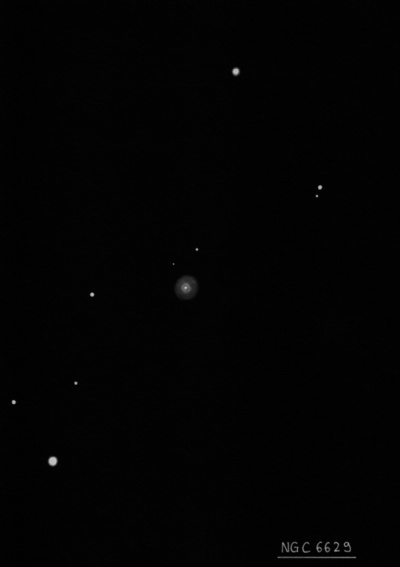
William Herschel discovered NGC 6629 = H II-204 = h3744 on 7 Aug 1784 (sweep 245) and reported "I suspected a pB, S, stellar nebula np a pB star, but there was too much daylight to verify it." John Herschel recorded (sweep 793 from the CGH) "pB; vS; 4" at the utmost in diameter; a good deal furry at the edges, and ? if not a little brighter in the M. It is not a "Stellar Nebula", but rather a link between a planetary and a globular; it probably a v distant and highly compressed globular; has a * 9m 3' dist, sf; night superb and vision perfect. This is one the smallest if not the very smallest nebulous objects I remember to have seen. It is a very remarkable object."
In 1915 Knox-Shaw reported it was a not a globular cluster, but a planetary nebula, based on a photograph taken at the Helwan Observatory with the Reynolds reflector. Curtis (1918) reported "..the central star is about mag 13. The nebular disk is 16"x14" in p.a. 150°, and is nearly equal density throughout, without ansae or other structural details." (Crossley photograph).
400/500mm - 17.5" (8/10/91): at 140x, very bright, small, 15" diameter, round, high surface brightness, crisp-edged. The mag 13 central star is visible with direct vision. Mag 9.4 SAO 186802 lies 2.1' SE. At 280x, the central star is easier to pick out within the high surface brightness nebulosity. A mag 15 star is visible 30" NNW and a mag 15.5 star is right at the NE edge.
600/800mm - 24" (7/11/18): at 375x; bright, small, round, high surface brightness, 15" diameter, sharp edge, bright central star. A mag 15.5 star is barely off the NNE edge (15" from center) and a 15.1 mag star is 25" NW of center.
Notes by Steve Gottlieb